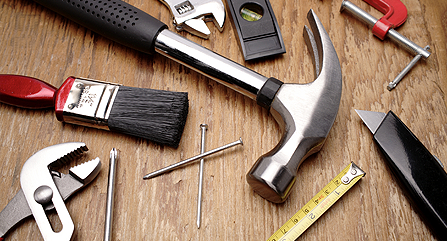Five Home Repairs You Should be Able to do by Yourself
Many homeowners are surprised to learn how many things around their house they can fix themselves and save the expense of calling in a professional. It is true that some jobs require a certain level of skill and must be performed with care, but they are doable. Here are five home repairs a homeowner should be able to do themselves:
Garage Door Repair
There are several types of garage door repair that a homeowner can do themselves. They include pulley-type doors malfunctioning because of slack in the cable, tension springs that aren’t tight enough, bar locks that don’t work because the assembly is misaligned and doors that bind because the tracks aren’t perfectly parallel to each other. One caveat is a homeowner should not repair or replace torsion springs, for these can cause serious injury if they’re handled the wrong way. Torsion springs should be left to a garage door repair professional.
Fixing Cracks and Holes in Masonry Walls
A homeowner who’s sees a crack in a masonry wall in their basement should wait a while before repairing it. In some newer homes, cracks are fairly normal and stabilize over weeks. But a crack that keeps getting bigger can be the sign of a major problem that needs a professional or minor leak behind the wall. In the latter case, the homeowner can use a cold chisel to cut the masonry back to sound material, bevel the edges and moisten them. The crack can then be packed with mortar.
Fixing a Double Hung Sash Window
If a double hung window won’t open because it’s been painted shut, run a utility knife between the sash, which is simply the part of the window that can open and the stop, which is the mechanism that keeps the sash from moving out of place. If the sash gets stuck between the stops, the stops can be separated by placing a wooden bock along their length and tapping the block with a hammer. When the window comes unstuck it can be lubricated with wax or even a bar of soap.
Repairing a Dry Wall Ceiling
A large hole in the ceiling can be patched easily if the joists are still in good condition. First, find an area near the hole that’s sound, then draw a square around the hole. Drill holes at the corners then cut out the square with a keyhole saw. Prepare a piece of plywood that’s 1/2 inch thick and 2 inches longer and narrower than the square. Put it in place and secure it with drywall screws. Then, cut out a drywall patch to the size of the square, butter it with compound and press it in place. Secure it with screws and add compound to the edges. Unroll drywall tape down the joints and press it into the compound. Let it cure for at least 24 hours then add another layer of compound. When the coat dries, sand it, then put on a skim coat with a taping knife.
Fixing a Leaking Toilet
Toilets tend to leak at the supply pipe, around the base or at the place where the toilet tank connects to the toilet bowl if they are separate pieces. For a leaking pipe, tighten the nut that holds the fitting to the tank. If that doesn’t stop the leak, shut off the water supply, empty the tank, take out the fittings and put in new washers or a new pipe.
If the leak is coming from the place where the tank joins the bowl, drain the tank and tighten the hold-down bolts, or put in new washers. A toilet that leaks around the base may also have loose hold-down bolts. If tightening them doesn’t work, remove the toilet and put in a new wax seal.















Comments are closed.